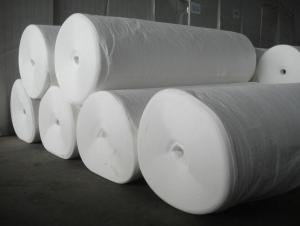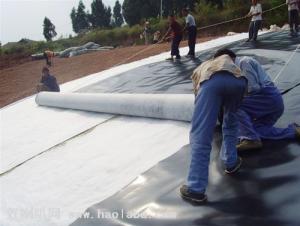Continuous Filament Spunbonded Nonwoven Geotextile forRoad and Railway station
- Loading Port:
- Tianjin
- Payment Terms:
- TT OR LC
- Min Order Qty:
- -
- Supply Capability:
- 5000rolls m²/month
OKorder Service Pledge
OKorder Financial Service
You Might Also Like
Continuous Filament Spunbonded Nonwoven Geotextile forRoad and Railway station
Made from ultrahigh molecular weight polyethylene (UHMW-PE) fiber and PET fiberby nonwoven
Needle punched manufacturing process.
Specification ContinuousFilament Spunbonded Nonwoven Geotextile for Road and Railway station:
1.200G/M2 - 1200G/M2
2lm-6m in roll width, the length as clients ' request
Continuous FilamentSpunbonded Nonwoven Geotextile for Road and Railway station Property:
L. Super high strength, ultralight, high resistance
2. Resistance to chemical erosion, excellent water resistance
3. Abrasion resistant
4. Excellent anti-aging and anti-UV property, good weather fastness
Continuous FilamentSpunbonded Nonwoven Geotextile for Road and Railway station Application:
I. Separation and stabilization in road and railway construction
2. Reinforcement project
- Q:What is the difference between woven and non-woven geotextiles?
- Woven geotextiles are made by interlacing yarns or fibers together, creating a strong and durable fabric. They have a high tensile strength and are commonly used for applications that require high load-bearing capacity, such as stabilizing soil or preventing erosion. Non-woven geotextiles, on the other hand, are made by bonding fibers together using heat, chemicals, or mechanical processes. They are generally less strong and more flexible than woven geotextiles. Non-woven geotextiles are often used for filtration, separation, or drainage purposes, where their permeability and ability to retain fine particles are important factors.
- Q:How do geotextiles contribute to the sustainability of construction projects?
- Geotextiles contribute to the sustainability of construction projects in several ways. Firstly, they can be used as a substitute for traditional materials, such as gravel or sand, which reduces the demand for natural resources and minimizes environmental impact. Secondly, geotextiles improve soil stability and prevent erosion, ensuring the longevity of structures and reducing the need for costly repairs or replacements. Additionally, these textiles can enhance the efficiency of drainage systems, leading to reduced water consumption and improved water quality. Overall, geotextiles promote sustainable construction practices by conserving resources, enhancing durability, and minimizing environmental degradation.
- Q:What are the factors to consider when designing with geotextiles?
- When designing with geotextiles, several factors need to be considered. These include the type and quality of the geotextile material, the specific application and project requirements, the site conditions and soil properties, the expected loads and stresses, the installation and maintenance procedures, and the long-term performance and durability of the geotextile. Additionally, factors such as cost-effectiveness, environmental impact, and regulatory compliance should also be taken into account during the design process.
- Q:Geotextile price geotextile how much money a square meter
- Geotextile is a new type of building materials, raw materials are polyester, polypropylene, acrylic, nylon and other polymer polymer synthetic fiber. In accordance with the manufacturing method is divided into: there are two types of geotextile and non-woven geotextile. According to the use of anti-seepage, anti-filter, drainage, isolation, reinforcement, protection, sealing and so on a variety of functions, based on a variety of factors, the price is not the same, we would rather discuss with the price, Hongxiang new materials company Meng Xiangyu that sell products is not just look at profits, if only the simple pursuit of profit level, it is too easy, but if you want to assume the responsibility of the consumer, the quality of the project Responsibility, but need to spend a lot of effort. To this end, we do not count the cost, put a lot of manpower and resources to innovation, to transform, choose the best materials and the best modern equipment, put a lot of manpower, material resources to innovation, to create brand value, Can create the greatest green benefits. High-end quality and green is a commitment, we promise not to short-term interests, betray the future!
- Q:Can geotextiles be used in the protection of retaining walls?
- Yes, geotextiles can be used in the protection of retaining walls. Geotextiles are often used as a filter or separation layer behind retaining walls to prevent the migration of fine soil particles and provide drainage. They help in distributing the load and reducing the pressure on the wall, increasing its stability and lifespan.
- Q:Are geotextiles suitable for use in rain garden systems?
- Yes, geotextiles are suitable for use in rain garden systems. Geotextiles help to retain and filter water, prevent soil erosion, and provide stability to the rain garden system. They also allow water to infiltrate slowly, reducing runoff and promoting better water management in rain gardens.
- Q:Eva waterproof board and ecb waterproof board What is the difference between the two
- 1, two are waterproof board, can be used for highway, railway tunnel seepage, but the product material is different, the appearance is not the same. 2, EVA waterproof board there are two conventional, one is a simple EVA waterproof board without composite geotextile, the other is combined with the geotextile EVA waterproof board. Two collectively referred to as EVA waterproof board are tunnel waterproof board, is the main material of the tunnel seepage. 3, ECB waterproof board There are two conventional, one is a simple white or black ECB waterproof board, the other is with self-adhesive asphalt waterproofing membrane. Both can be used for tunnel seepage.
- Q:In the river within the construction of flexible piping can use geotextile to do anti-floating measures
- Yes, I am specialized in producing the installation
- Q:What is PAG in PAG composite geotextile
- Should be a high-strength glass fiber or grille and non-woven woven or bonded together geotextile, PAG is estimated that the product is a product code, one may be nominal vertical and horizontal strong, similar geogrid Such as PAG50-160, the other may be used cloth and grille specifications, such as 50kn grille and 160 grams of nonwovens
- Q:Is there a coinage between the embedded pipeline and the gravel blind ditch? Also on the backfill plant how to set the quota? Also ask the master advise! More
- You can go to the civil online forum to ask questions, there are a little more professional.
1. Manufacturer Overview |
|
|---|---|
| Location | |
| Year Established | |
| Annual Output Value | |
| Main Markets | |
| Company Certifications | |
2. Manufacturer Certificates |
|
|---|---|
| a) Certification Name | |
| Range | |
| Reference | |
| Validity Period | |
3. Manufacturer Capability |
|
|---|---|
| a)Trade Capacity | |
| Nearest Port | |
| Export Percentage | |
| No.of Employees in Trade Department | |
| Language Spoken: | |
| b)Factory Information | |
| Factory Size: | |
| No. of Production Lines | |
| Contract Manufacturing | |
| Product Price Range | |
Send your message to us
Continuous Filament Spunbonded Nonwoven Geotextile forRoad and Railway station
- Loading Port:
- Tianjin
- Payment Terms:
- TT OR LC
- Min Order Qty:
- -
- Supply Capability:
- 5000rolls m²/month
OKorder Service Pledge
OKorder Financial Service
Similar products
New products
Hot products
Hot Searches
Related keywords





























